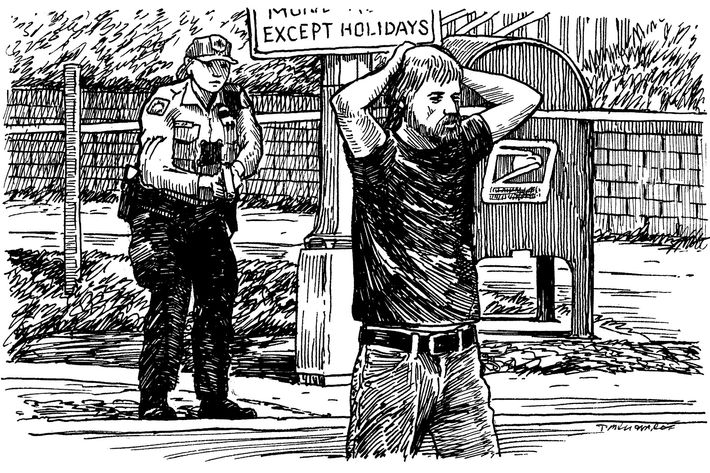1. To understand this new right, it helps to see it not as a fringe movement, but a powerful counterculture.
When did the right wing get so bizarre? Consider: For a brief and confusing moment earlier this year, milk somehow became a charged symbol of both white supremacy and support for Donald Trump. The details are postmodern, absurdist, and ominous — not unlike the forces that brought them about. In January, the actor Shia LaBeouf mounted an art installation designed to protest the president. The next month, neo-Nazis who organized on the message board 4chan crashed the show, where they started chugging from milk jugs — because northern Europeans digest milk well, or because milk is … white. In other words, an innocent dairy beverage as old as time had been conscripted as a Donald Trump surrogate on the internet. It was yet another message-board in-joke — freighted with political meaning — suddenly in the news.
But weirdness, perhaps, is what happens when a movement grows very quickly and without any strong ideological direction — from a disciplined party, from traditional institutions like churches and chambers of Congress, from anything more organized than the insurrectionist internet.
Here in America, in trying to describe our brand of the reactionary wave currently tsunami-ing the entire developed world, we’ve leaned on the term alt-right, which had been coined by white supremacists. Richard Spencer, the most press-hungry of that group, takes credit for it. For much of last year, the term was often used as shorthand for “racists, but … young?” Which is helpful, as far as it goes, but the full reality is much more complicated. The alt-right — or the new right, if you prefer to sound more like Tom Wolfe than Kurt Cobain, or the radical right, to properly acknowledge its break from mainstream conservatism — is a coalition comprised of movements like neo-reaction, certain strands of libertarianism, tech triumphalism, and even the extreme-populist wing of the Republican Party. All share with Spencer’s white-ethno-nativism the ideals of isolationism, protectionism, and nationalism: a closed nation-state. Along the way, the coalition swept up “men’s rights” advocates and anti-Semites and cruel angry teenagers and conspiracy theorists and a few fiendishly clever far-right websites and harassing hashtags and even a U.S. congressman or two. Not to mention the White House.
But to approach the big messy tent of the new retrograde right — the international brigade of nativist-nationalists, tech-savvy anti-globalists, the porn-loving gender traditionalists — as primarily a political movement is to wildly underestimate its scope. Reactionary energy helped deliver all three branches of government to a Republican Party in the grips of an alt-right-curious anti-PC bomb-thrower the faithful called their “god-emperor” (or at least helped him along with last year’s affirmative action for white people, a.k.a. the Electoral College). But at no point during the campaign, even, could you have mistaken the unruly energy on the right for anything so organized as a party or as purposeful as a protest movement. It was — and is — a counterculture. One formed in the spirit of opposition to everything the existing Establishment stood for: globalist, technocratic liberal elitism. The amazing thing is, in November, for the first time in American electoral history, the counterculture won everything.
This didn’t happen out of nowhere; the new reactionary spiderweb is just as much of a referendum on our world as the Obama coalition was. This still-young century’s most potent political movements have been about reckoning with the rapid progress of the last one; in the Obama surge, there was contained the hopeful notion that the changes had been good, that they were not an end in themselves but merely the beginning of something even greater and brighter still to come. And in this far-right movement, there is instead a backlash to those same changes and those same symbols — to a black president, to a woman candidate, but also to the idea that diversity and inclusiveness and the other major social movements of the 20th century even represent progress at all, rather than its inverse. To many on the radicalized right, social progress is a zero-sum game in which minority groups and women have been winning at the expense of the previous kings of the castle. Moreover, other forces are ransacking the castle, too — namely, technology, globalization, and financialization. Yet how they believe one should actually go about addressing those problems can be difficult to parse, especially when the complaints are often filtered through 140 characters of unprintable vitriol and hate.
So what follows here is an attempt to really reckon with the alt-right and its fellow travelers: to organize and catalogue influences, philosopher-kings, and shit-posting foot soldiers; to track the movement’s history, its future, and the story of how the modern internet made it possible; to study its grievances, its media savvy, its symbols, its heroes and villains, its president and its critics of the president, its billionaire supporters and the underemployed message-board-dwelling “advocates” who serve as its creative engine. The movement is not a monolith — though it would also never be mistaken for a rainbow coalition — and part of what we’ve focused on is just how the various wings work together in concert. How does Steve Bannon relate to Russia Today, and what do conspiracy theorists have in common with pickup artists and Nazi Furries? How do memes like milk become weaponized, and just when did 4chan get political? How do its beliefs get amplified into the larger culture?
For all its theoretical anti-modernity, the alt-right is a uniquely modern movement, after all, enabled in reach by the connective tools of the social internet and by the clever use of the sort of irony that every young American raised on TV and memes recognizes as our pop-culture lingua franca. It’s an irony they’ve used as armor, too: If you take them seriously, they’ll claim you missed the joke. But of course, by treating them as a joke, you can miss their importance — as so many of us who planned our November 9, 2016, around a certain Hillary Clinton win did.
In some ways, it’s easy to define the movement by what it doesn’t care about. Not just the pieties of the left, but those of the Establishment Right as well: corporatism, taxes, cultural inclusiveness at a rhetorical level at least. Much as the tea party (a small group punching above its weight class through lunatic obstinacy and support from the Koch network) hijacked the Republican Party from inside by appealing to its sense of purity, the alt-right (a small group punching above its weight class through sheer lunatic web-savvy) swerved the party off its plotted course by an obsessive focus on some of the uglier, and often unofficial, aspects of the GOP platform that had been used for decades to appeal to the ever-poorer and less-educated base of the party.
You can also see the movement as a response, more than 15 years later, to 9/11, modernity’s starkest testing point to date. The alt-right’s fixation on the dangers of radical Islam has a kind of poetic irony to it: Like ISIS, it is fringe extremist, punkish, and digital in its pursuit of medievally brutal goals, more focused on blowing up the existing system than creating a new one. It, too, is tribal and nihilistic. But the alt-right’s rise is also a response to America’s post-9/11 landscape. You can see it in the fierce anti-interventionism of the movement and in the sharp, angry, often conspiratorial distrust of elites, who have often seemed to be the only ones prospering since then.
And, just maybe, the alt-right reflects the shift in America’s definition of itself after that catastrophic terror attack. Jingoistic nationalism bubbled up, sure, but there was also that slow erosion of liberties in the name of security, a seeping illiberalism that seems to have taught the rising generation that democratic norms are malleable. The young left, too, not only despises the previous generation’s deal-making Establishment but has a taste for autocratic control, in its (far less harmful) focus on PC language-monitoring and its belief that sometimes people you disagree with shouldn’t be allowed to speak their piece. It’s a funhouse-mirror version of the alt-right, which uses the cloak of free speech to spit out hate-speech and turns the accusations of fascism right back on its lefty enemies who cry foul.
The alt-right is itself still small; 54 percent of Americans hadn’t heard of it even after the election of Donald Trump. But the new reaction of which it is a part is quite large — in fact, truly global. Which means that the movement’s grip on the White House — which seems to wax and wane, now with Gary Cohn looking like he’s taken Steve Bannon’s seat in Trump’s game of musical chairs — is not its strongest claim on the future. Whatever happens in Trump’s Washington — and, who knows, we may soon be seeing more of Ted Nugent and Kid Rock than cronies from ExxonMobil and Goldman Sachs — there are still heroes abroad for them (Marine Le Pen, until her runoff at least, along with Nigel Farage and his pro-Brexit pals, and more sure to come). As with any counterculture, though, the politicians will come and go. The more lasting battle is outside politics, in the culture and especially on the internet. Where, you might remember, we all live now. —Noreen Malone
2. With a worldview based entirely on resentment: of seven things in particular.
Immigrants: New arrivals diluting the imagined racial purity of nation-states.
Globalists: Promoters of free trade, exchange, and movement across borders.
Snowflakes: College students and Twitter users offended by racist, sexist, and homophobic jokes.
Feminists: Women who insist on equal treatment and equal rights.
Interventionists: Bleeding hearts disturbing the sovereignty of foreign states.
Journalists: Clueless, out-of-touch, hopelessly liberal media.
Elites: The rich puppet-masters of a decadent West.
3. The movement’s new vanguard is teenage “shitlords*.” The world is their message board now.

For most of last year, it was hard to avoid the sensation that something had broken somewhere and the internet was leaking into real life. The world seemed to have taken on the punchy, disorderly, darkly playful quality of a message-board fight, in part because the president-to-be insisted on communicating mainly in tweets assembled from detritus found in a Breitbart-comments scrapyard. The subcultures and folkways of the internet had become powerful enough that the entire election apparatus was obligated to attend to and dissect them. In January, the Republican consultant Rick Wilson dismissed a portion of Trump supporters as “childless single men who masturbate to anime”; by September, the Clinton campaign was concerned enough with the threat of meme warfare that it released an explainer denouncing the cartoon frog Pepe under the title “Donald Trump, Pepe the frog, and white supremacists: an explainer.” When Election Night rolled around, it was hard to begrudge the exuberant 4chan poster, thrilling in his candidate’s surprise victory, who bragged that “we actually elected a meme as president.”
It was a shocking turn, and not just because Donald Trump had become president. Somehow the self-proclaimed losers and freaks of 4chan and its ilk had come to great political prominence. The gleaming new real-name internet of Facebook — not to mention the media companies and political machines relying on it — that was supposed to tame the wild territory of the Reddit-style web had instead been infected by it. It was almost a thrilling underdog story — the weirdos and outcasts had stood up for something and won — except that the thing they were standing up for was anti-Enlightenment, anti-democratic, anti-equality politics.
Whatever else the alt-right is, it is a movement born and incubated on the internet, and it couldn’t have existed without that technology. Circulation, discussion, and debate are oxygen to political ideas. Commercial and social mechanisms like “the cost of owning a printing press” and “No one will invite you to parties if you openly praise Hitler” traditionally cut off extreme thinkers from mass circulation. Now, though, you can reproduce your ideas essentially infinitely, for prices so low as to be effectively free, and suffer no ill social effect. In fact, online, toxic ideas are more likely to get attention and social capital (plus, thanks to programmatic ad networks, real capital) that goes along with attention.
And there is a literal army of dissatisfied, disenchanted, mostly male young adults ripe for radicalization. The internet is host to what the writer and programmer David Auerbach calls “the first wide-scale collective gathering of those who are alienated, voiceless, and just plain unsocialized” — seeking freedom from the disappointments of the physical world in places where social interaction is decoupled from material and emotional signals they don’t understand or have access to. “There’s people that are, like, behind the counter at a Pizza Hut or whatever, and their intellect and their skills are not being used in the real world in a way that’s appealing to them,” the web-comic artist and longtime 4chan observer Dale Beran tells me. “The only interesting stuff that’s going on is the internet and video games.”
[Read the full article on Select All >>>]
*Shitlord (n.): A reappropriated insult for online trolls who spam social media and message boards with vile right-wing memes, just for giggles.
4. Which is why the movement expresses itself this way.
Memes of the alt-right.
Pepe (above)
The main mascot.
This perverted-looking frog was born in 2005 as a zoomorphic stoner in a comic book called Boy’s Club. There was something about Pepe’s shameless id fulfillment that translated well to teenage internet culture. Pepe started appearing on the message board 4chan, then in increasingly mainstream manifestations (“Borat Pepe”) until, in 2015, he became Tumblr’s most popular meme. A group of young white nationalists resolved to make him “toxic” and reclaim him from the “normies.” That they did, creating Nazi and skinhead versions of Pepe. When Donald Trump ran for president, the frog began to appear with Trump hair or a red #MAGA hat; by 2016, he was associated almost uniquely with the alt-right.

Moon Man
Racist rapping cartoon.
In 1986, Mac Tonight was a bright-white, sunglasses-wearing, crescent-moon-headed McDonald’s advertising character. In 2017, he is “Moon Man,” a rapper character used as a kind of collective pseudonym by anonymous members of the alt-right, who upload obscenely racist rap parodies to YouTube and credit them to the cartoon pitchman. It’s likely because he bears an incredibly vague resemblance to a hooded Klansman.

God-Emperor
Donald Trump.
The title bestowed by members of the devoted Reddit community r/the_donald. In the past, “god-emperor” has been used by historians and subjects to describe the Roman and Japanese emperors; Jesus Christ; and massive, immortal, psychic human-worm hybrid Leto II Atreides from Frank Herbert’s sci-fi novel God Emperor of Dune. It is unclear which god-emperor the president is meant to recall.

Trash Dove
Disputed territory.
Trash Dove is, depending on who you talk to, either a cute Facebook sticker adopted by liberals as a Pepe-like meme mascot; a cute Facebook sticker ironically appropriated by the alt-right because it was adopted by liberals; a cute Facebook sticker earnestly identified by liberals as an alt-right hate symbol even though it was actually ironically appropriated by the alt-right because it was adopted by liberals; or just a cute Facebook sticker.

Based Stickman
The good squad.
Kyle Chapman is a 41-year-old Californian who showed up to a pro-Trump rally in Berkeley with a gas mask, a shield, and, yes, a stick, thereby earning this nickname upon his arrest. (“Based,” as coined by the rapper Lil B, has become internet slang for, essentially, “glorious.”) Chapman has announced plans to start a “tactical defensive arm” of an alt-right social club led by Gavin McInnes.

The Cult of Kek
Irony as religion.
Around 2010, the Korean-derived term Kek gained popularity on 4chan as a hipper way to say LOL. It turned out that Kek was also a name of the ancient-Egyptian god of chaos, who happened to resemble a frog. Thus was born the Cult of Kek, in which young Trumpists supposedly worship a pagan deity and its present-day avatar, Pepe the Frog, who controls world events through “meme magic.”

“Deus Vult”
A Crusader battle cry.
“God wills” in Latin. Rediscovered thanks to the video game Crusader Kings II and now deployed in memes about the Crusades, in YouTube comments, and, in a handful of instances, as graffiti on the walls of mosques.
5. Andrew Sullivan: Why the Reactionary Right Must Be Taken Seriously

Look around you. Donald Trump is now president of the United States, having won on a campaign that trashed liberal democracy itself, and is now presiding over an administration staffed, in part, with adherents of a political philosophy largely alien to mainstream American politics. In Russia, Vladimir Putin has driven his country from postcommunist capitalism to a new and popular czardom, empowered by nationalism and blessed by a resurgent Orthodox Church. Britain, where the idea of free trade was born, is withdrawing from the largest free market on the planet because of fears that national identity and sovereignty are under threat. In France, a reconstructed neofascist, Marine Le Pen, has just won a place in the final round of the presidential election. In the Netherlands, the anti-immigrant right became the second-most-popular vote-getter — a new high-water mark for illiberalism in that once famously liberal country. Austria narrowly avoided installing a neo-reactionary president in last year’s two elections. Japan is led by a government attempting to rehabilitate its imperial, nationalist past. Poland is now run by an illiberal Catholic government that is dismembering key liberal institutions. Turkey has morphed from a resolutely secular state to one run by an Islamic strongman, whose powers were just ominously increased by a referendum. Israel has shifted from secular socialism to a raw ethno-nationalism.
We are living in an era of populism and demagoguery. And yes, there’s racism and xenophobia mixed into it. But what we are also seeing, it seems to me, is the manifest return of a distinctive political and intellectual tendency with deep roots: reactionism.
Reactionism is not the same thing as conservatism. It’s far more potent a brew. Reactionary thought begins, usually, with acute despair at the present moment and a memory of a previous golden age. It then posits a moment in the past when everything went to hell and proposes to turn things back to what they once were. It is not simply a conservative preference for things as they are, with a few nudges back, but a passionate loathing of the status quo and a desire to return to the past in one emotionally cathartic revolt. If conservatives are pessimistic, reactionaries are apocalyptic. If conservatives value elites, reactionaries seethe with contempt for them. If conservatives believe in institutions, reactionaries want to blow them up. If conservatives tend to resist too radical a change, reactionaries want a revolution. Though it took some time to reveal itself, today’s Republican Party — from Newt Gingrich’s Republican Revolution to today’s Age of Trump — is not a conservative party. It is a reactionary party that is now at the peak of its political power.
The reactionary impulse is, of course, not new in human history. Whenever human life has changed sharply and suddenly over the eons, reactionism has surfaced. It appeared in early modernity with the ferocity of the Catholic Counter-Reformation in response to the emergence of Protestantism. Its archetypal moment came in the wake of the French Revolution, as monarchists and Catholics surveyed the damage and tried to resurrect the past. Its darkest American incarnation took place after Reconstruction, as a backlash to the Civil War victory of the North; a full century later, following the success of the civil-rights movement, it bubbled up among the white voters of Richard Nixon’s “silent majority.” The pendulum is always swinging. Sometimes it swings back with unusual speed and power.
[Read the full article here >>>]
6.Their thought leaders are obsessed with the past — but saw a way to win the future.

Pat Buchanan
The proto-Trump.
The first modern presidential candidate to test the appeal of overt bigoted populism, Buchanan worked as a journalist before migrating to the Nixon White House and coining the phrase “silent majority.” He ran for president in 1992 on an “America First” platform, during which he disputed the number of Jews killed at Treblinka, called AIDS nature’s retribution against gays, and argued for rounding up homeless people. He also proposed a U.S.-Mexico border wall dubbed “the Buchanan fence.”

Jared Taylor
Straight-up white nationalist.
In 1990, Taylor founded what would become the influential magazine American Renaissance, which staked out two fundamental positions on race. First: The white one was intellectually and culturally superior to the other ones. Second: It was perfectly natural for Caucasians to band together to preserve their racial majority.
Hans-Hermann Hoppe
German … and into “removal” of certain humans.
Hoppe is a German libertarian academic who favors radical free-market economics, the abolition of the federal state, and highly restrictive immigration policies. In Hoppe’s supposedly libertarian utopia, those advocating “individual hedonism, parasitism, nature-environment worship, homosexuality, or communism” would be “physically removed” from society. Since 2006, he’s hosted a conference called the Property and Freedom Society, held every summer in a Turkish resort town. Davos, but for racists. Lectures include “The Looting of Germany: 1945–Present” and “What Is and Isn’t Fascism.”

Paul Gottfried
Nativist strategist.
Gottfried, a Yale Ph.D. (and son of a Hungarian immigrant), spent a career agitating for an ethno-nationalist conservatism that celebrated white Western values and lamented what feminism and multiculturalism had done to dilute them — perfect for Pat Buchanan, whose 1992 presidential campaign he advised.
Peter “Taki” Theodoracopulos
The proto–Gavin McInnes.
An elderly Greek playboy who named one of his dogs “Benito,” once spent three months in jail for cocaine possession, and runs the leading publication for hepcat paleoconservatives and cosmopolitan racists: Takimag, which prides itself on telling hard truths about the superiority of whites without being “boring” about it.
Nick Land
Violent technologist.
Land, a British former academic who blogs from Shanghai, is the in-house philosopher of “neo-reactionism.” An “accelerationist” who wants to follow capitalism to its extreme, hurtling human beings into the Hobbesian, robot-dominated future they deserve, Land also publishes e-books of “Abstract Horror” fiction.

Steve Sailer
White-identity Electoral College savant.
After Mitt Romney’s 2012 loss to Barack Obama, the Republican establishment undertook a rigorous postmortem and, looking at demographic trends in the United States, determined that appealing to Hispanics was now a nuclear-level priority. And yet their successful candidate in the next election won by doing precisely the opposite. The Trump strategy looked an awful lot like the Sailer Strategy: the divisive but influential idea that the GOP could run up the electoral score by winning over working-class whites on issues like immigration, first proposed by the conservative writer Steve Sailer in 2000, and summarily rejected by establishment Republicans at the time. Now, 17 years and four presidential cycles later, Sailer, once made a pariah by mainstream conservatives, has quietly become one of the most influential thinkers on the American right.
Sailer, a California native and the son of a Lockheed engineer, became journalist in his mid-30s, starting his career contributing to National Review in the 1990s. His specialty was a plain-spoken form of science journalism, numerate and clued-in to developments in genetics and evolutionary theory, but also infamous for applying, often in a blunt and inflammatory manner, such methods to alleged racial differences in intelligence and behavior. Indeed, Sailer popularized the term “human biodiversity” (HBD) — now a mainstay on the alt-right — to describe his field of interest, which, despite winning a few lonely adherents in the academy, has been dismissed by critics as pseudoscience at best and eugenics at worst.
Sailer’s brief career at National Review ended in 1997, when William F. Buckley, Jr. eased out the magazine’s then-editor, the immigration hawk John O’Sullivan, in favor of Rich Lowry — part of a larger shift in the conservative world away from paleoconservatives and immigration skeptics near the turn of the millennium. Since then, he has largely been confined to smaller and less mainstream conservative outlets. But after Trump won last November by getting blue-collar, Midwestern whites to vote like a minority bloc, as Sailer had so memorably recommended in 2000, a number of Sailer’s establishment critics, such as Michael Barone, were forced to acknowledge that Sailer had been vindicated. —Park MacDougald and Jason Willick
[Read the full article on Steve Sailer here >>>]
7.(By the way, the left wants to blow things up too.)
Dissatisfaction with the Establishment doesn’t always force people rightward. The surprisingly successful candidacies of old-school lefties like Bernie Sanders, Jeremy Corbyn, and Jean-Luc Mélenchon are evidence of an active contemporary “alt-left”: “alt” as in alternative to the corporate-friendly liberalism of the diminishing center-left (see surging membership in Democratic Socialists of America), “alt” as in irony-fluent, and meme-adept (see the dirtbag-left podcast Chapo Trap House), and “alt” as in dismissive of, if not abjectly cruel toward, any identity politics that doesn’t place class at the center. The alt-left hates nothing more than being called the alt-left.
8.Beyond Le Pen: The world’s nationalists.

Germany | Alternative for Germany
Alternative for Germany’s leader, Frauke Petry, has suggested German border police should have the right to shoot refugees illegally crossing the border. Last year, her party doubled its representation in regional parliaments.
Greece | Golden Dawn
Campaigning on a promise to “rid the land of filth,” the anti-immigrant, violent Golden Dawn became the country’s third-largest party after the 2015 elections.
Italy | Northern League
Matteo Salvini, the leader of the far-right Northern League, wants to expel all undocumented immigrants and has reportedly praised the “good work” of Benito Mussolini. (Salvini claims Trump hopes he becomes Italy’s next prime minister.)
Hungary | Jobbik
Hungary’s second-largest party, Jobbik was the first to propose a border wall to block refugees; it also wants to ban Budapest’s gay-pride parade and suggests the Roma people are all criminals.
India | Bharatiya Janata Party
Prime Minister Narendra Modi’s party has incited violence against Muslims and threatened to remove Muslims from “Hindu areas.” A member of Parliament who once supported killing Muslims was recently appointed by Modi to lead India’s most populous state.
Sweden | Sweden Democrats
Support for the nationalist Sweden Democrats has nearly doubled since the 2014 general election, making it arguably the country’s most-popular party. In February, party leader Jimmie Åkesson penned a Wall Street Journal op-ed praising Trump’s claim that immigration has led to a local crime wave.
Slovakia | Kotleba-People’s Party
Kotleba, which won 8 percent of the seats in Parliament in 2016, openly embraces the country’s Nazi past. Party leader Marian Kotleba has compared Slovakia’s Nazi-era regime to “living in heaven” and called NATO a “terrorist” organization.
South Africa | South African First
Mario Khumalo, founder of this new anti-immigrant party, has promised that if it came to power, his party would kick out all immigrants and seal South Africa’s borders within 48 hours of taking office. Nigerian and Somali migrants have been the targets of violent attacks.
—Jordan Larson
9.What are the roots of this rage?
Where does the alt-right come from? Is it just a new word for racism? Is it a response to economic anxiety? We spoke to historians, sociologists, and thinkers for their perspective.
White supremacy. Pure and simple.
“These are the same kind of folks who used to be called white supremacists, renamed themselves in the ’80s as white nationalists to sound less bad, and now have rebranded themselves to look more like they’re part of the right wing. Until the Trump run, most of the people in this movement — white supremacists, white nationalists — had no time for either political party. They basically felt like neither of the parties were appealing to their racial interests. Dog whistling wasn’t enough for them. When Trump attacked Mexicans on day one and then went on to say all kinds of terrible things that were not dog whistles — they were bullhorns — that was certainly seen as a positive for them. —Heidi Beirich, director of the Southern Poverty Law Center’s Intelligence Project
And is fueled by the well educated and underpaid.
“Based on the interviews I’ve been doing, members of the alt-right are definitely higher educated [than most Trump voters]. It is a movement that is pretty technologically literate, so it is qualitatively different from the KKK of a generation ago. What some have speculated about, actually within the alt-right itself, is that one of the causes for its growth is that there is a growing number of very skilled and rather talented people who are not of the social status that one might anticipate given their levels of education. So they’re very well trained, very well educated, and they have a lot of time on their hands. So it’s maybe a lot of people who got good STEM degrees and ended up moving back in with their parents. One of the key ways to destroy a budding radical is to make him or her firmly ensconced in the bourgeoisie. Once you are dealing with mortgage payments, you’re not spending time on the internet trying to foment revolution anymore. Part of the problem is this large population that has time and has skills, and it’s angry. There are people who are quite bitter about their experiences and the alt-right tells them that they have answers for them.”
“The alt-right is not as large as it’s able to appear online. My general argument is that around 2015 or so, what the alt-right did and did very successfully, was through social media, especially Twitter, they created this sort of Potemkin village that they would put up in front of opinion leaders, especially journalists, so that every time they fired up their computer they would see a constant barrage of white-nationalist, anti-Semitic remarks, giving the impression that there was this massive online Nazi army that was taking over the internet. Particularly anti-Trump journalists, particularly Jewish journalists, and particularly if you were a conservative anti-Trump Jewish journalist, if you were to go online, someone from the alt-right was probably there to troll you. I don’t want to say the trolling of the alt-right was super-coordinated, but there were certain personalities that were very likely to be targeted by anonymous alt-right folks on social media. And starting around 2015 you began to see these big stories about this new scary movement called the alt-right, and in a way it sort of became this self-fulfilling prophecy. I think the real change especially occurred about Hillary gave her Reno speech in which she denounced the alt-right. Which, at that point, I think the growth of the movement really sped up. Which is not to say that she necessarily made a mistake, but the alt-right viewed it as a major victory to be brought into the national conversation that way.” —George Hawley, political scientist and author of the forthcoming Making Sense of the Alt-Right
But what if the real cause is modernity itself, which is just a racist construct?
“Any deep response to modernity is rooted in racism. The Enlightenment project itself — reason, rationality, scientific inquiry, the quest for objectivity, are rooted in and indistinguishable from a racist conception of who wields reason and why. Remember, Thomas Jefferson in Notes on the State of Virginia was skeptical about the rational capacity of the Negro to engage in serious and critical reflection. The denial of black reason and humanity and intelligence go hand in hand with the rise of modernity. So the alt-right amplifies and echoes some of the worst elements of modernity itself, which is indissolubly linked to the denial of legitimate rationality among people who are seen as marginal minority in a subculture. We can’t escape it by saying ‘Those people over there are horrible.’ The alt-right is merely echoing some of the premises, presuppositions, and perspectives that have been deeply entrenched in modern western civilization and profoundly articulated at certain levels across the spectrum of political and ideological communities. It is the heinous, disfigured manifestation of a smoother, far more sustained bigotry and polite racism that have taken root in our culture.”
“At least we know what we’re dealing with in the alt-right. There’s no pretense at attempting to engage in the politics of tolerance. That’s out the door. Sessions stopping all agreements between the Department of Justice and police departments, that is a severe blow and an expression, although less polite, of an alt-right ideology.”
“This election was said to be about two contradictory things. The end of identity politics and simultaneously without a sense of contradiction the reassertion of the white working class. As if the white working class is not rooted in identity politics. Whiteness is our culture has been pretty consistent. It’s been denying its particularity and its roots in a specific economic or cultural or class formation as a race and sees itself as a universal. When white people hear race, they think black, brown, red, and yellow; they don’t think white. That’s why white people can say, “Why don’t you people stop talking about race?” They believe that they are Americans. They don’t have a race. They think they don’t have a commitment to a particular ideology other than an ostensible neutrality and objectivity.” —Michael Eric Dyson, professor of sociology, Georgetown University
Whatever its root cause, the movement will likely only grow.
“For many in this movement, being American is part of a civilizational identity, not a set of ideas that anyone can buy into or share. There’s a strong civilization component to most Islamist groups as well — not like ISIS, but the mainstream Islamists who participate in politics. One thing you’ll find, regardless of the spectrum, is a strong sense of Islamic religious civilization. That’s different because the alt-right privileges ethnicity. They’re two very different approaches to civilization and identity, but the same basic idea of trying to draw clear lines between large groups of people based on whatever ideology they subscribe to.”
“ISIS and the Bannon-ites, they feed off each others’ rhetoric. ISIS and Bannon both want to promote civilization struggle. There’s no moral equivalence between the two, but much of this rhetoric is an endless loop of being reactionary. With groups like ISIS, you have to be attuned to the risk of feeding into a civilizational narrative of war on Islam. This is where the alt-right doesn’t distinguish — all Muslims are guilty until proven innocent. They have to prove loyalty to America. It calls into question the very notion of citizenship — as an American Muslim, I shouldn’t have to say that I’m loyal to America. It goes against the core element of American identity.”
“As the white population becomes a smaller majority and ultimately a minority, there is going to be more white panic. It’s not super-common as a natural democratic process. How will people deal with that? Whites would be a powerful majority in the economy and politics, which creates a dangerous-imbalance power dynamic, like the dangerous sectarian resentments seen in some Middle Eastern conflicts. That’s why I’m not super-optimistic about this, unless we can allow some room for a legitimate expression of white identity. White self-interest that doesn’t discriminate against others, that isn’t racist toward minority groups. A stark understanding of “You’re a racist or non-racist,” is not a good idea and not sustainable.”—Shadi Hamid, senior fellow at the Brookings Institution and author of Islamic Exceptionalism
[Read the full article here >>>]
10.What came before it?
From the 1970s on through the militia heyday of the Clintonian 1990s, the far right of the popular imagination was “survivalist”: The gun-wielding, camo-clad, angry white man in the woods ranting against minorities and ZOG (the Zionist Occupation Government). In other words, at least in the slick liberal perception, someone like Randy Weaver, a Green Beret veteran working at a John Deere factory who decided to leave the corrupt, doomed society of 20th century America for the remote Ruby Ridge in the northern Idaho panhandle. Much of Weaver’s decision owed to the deep religious convictions of his wife, Vicki, who found scriptural inspiration in Matthew 24:15 (look it up) and had a vision of a Paradise where their family might be safe from the coming Tribulations. The rest of the story is about the destruction of that Paradise, the Feds entrapping Randy to saw off some shotguns, telling him they’d let him go if he informed on friends at the Aryan Nation compound down the road. Weaver refused to play Judas, thereby setting off a series of events that led to the surrounding of Ruby Ridge by vindictive government forces in August 1992, a story that ended in a confrontation during which Vicki Weaver was shot dead by an FBI sniper while holding their 10-month-old in her arms. Still, Randy Weaver would not give in, holding out for the next 11 days even as his wife and son Samuel lay dead nearby.
With the passing of the 1990s right-wing cosmographic triptych of Ruby Ridge, Waco, and Oklahoma City, the survivalist movement gave way to the rise of suburban “prepper.” In comparison to larger-than-life personalities of the ’90s, the prepper movement presents itself as one more Amazon Prime–based cargo cult. For sure, Randy Weaver wasn’t allowing some “expert” from the doomsday-prepper reality show to come into his house and give his rainwater-collection system a B-minus.
The new alt-right movement might share many of the beliefs of the survivalists and militiamen of the ’90s like Weaver — ideas about race, immigration, and “globalism” among them. But would those haters go the limit for Paradise the way he did? Buttoned down like some latter-day Eurofascists, likely they’d be too rootlessly cosmopolitan, like many of the Jews they profess to despise, for something like that. —Mark Jacobson
11.Like the evangelical right or the new left, the new right is its own social universe … with strange totems …

Milk
Dairy fascism.
In January, Shia LaBeouf mounted an art installation in Queens designed to protest Donald Trump. In February, neo-Nazis crashed it and started chugging from milk jugs. A couple theories about why: One, birthed on 4chan, is that white Europeans digest milk well. Another is that milk’s color is white.
New Balance
Shoes for white people.
After the election, the company’s PR guy lauded Donald Trump for his opposition to the Trans-Pacific Partnership; New Balance manufactures some of its shoes in America. Outraged, some liberals burned their sneakers. Meanwhile, Daily Stormer editor Andrew Anglin declared it the “official shoe” of the white race. It’s unclear if the idea caught on, because New Balance was already the official shoe of the white race.
Jane Austen
Old-fashioned heroine.
Anglin associates the 19th-century novelist with sexual purity and Taylor Swift. “She is the anti-Miley,” he has said of Swift. “While Miley is out having gang-bangs with colored gentlemen, she is at home with her cat reading Jane Austen.” Milo Yiannopoulos has suggested there is an anti-feminist current to Austen’s work. (He also misidentified her as a Victorian.) Still others see her novels as a blueprint for white, genteel utopia.
Nazi Furries
Swastika fetishists.
People who dress up in furry-animal suits call themselves “Furries” and attend conventions with names like Rocky Mountain Fur Con 2017. Lately, a specter has haunted the community: Nazi Furries, led by one notorious Furry called Foxler, who dresses in a black short-sleeved shirt, a red tie, and a red armband. Foxler denies being a neo-Nazi, despite reportedly making comments like “I stand by Hitler.” In anticipation of Rocky Mountain Fur Con 2017, he attempted his first coup, booking 30 hotel rooms for his “Furry Raiders.” Organizers feared violence, and in April the convention was canceled.
Dilbert
Alienated alt-right recruit.
In Scott Adams’s comic strip “Dilbert,” the sadistic corporate executive Dogbert mercilessly promotes his own career at the expense of others. In one strip, he publishes a fraudulent tabloid filled with sunny lies about himself. In another, printed in the 1990s, he is asked by a Russian if “your god is Donald Trump?” Dogbert replies, “I don’t think it’s official yet.” In 2015, Adams began predicting a Trump victory on the basis of Trump’s “Master Wizard” rhetorical techniques. For several years now, Adams, a manosphere hero, has been griping about the cuckolded American male. “Dilbert” itself, read as an alt-right text, becomes a comment on alienated white men, stifled by modernity.
12.New slang …
Around the time Steve Bannon lost his spot in President Trump’s National Security Council, a reporter at the Daily Beast spoke to an unnamed White House official who described Bannon’s rage. America’s most powerful alt-righter had “vented to us about Jared being a ‘globalist’ and a ‘cuck,’ ” the official said. “He actually said ‘cuck,’ as in ‘cuckservative.’ ” And there it was, the moment when a niche neologism moved, fully and incontrovertibly, into the mainstream — and explained the neurotically masculinist world whence it came.
Cuckservative, the portmanteau that insults moderate Republicans by accusing them of being cuckolds — men whose wives cheat on them — started trending in the alt-right two years ago. The day after Donald Trump announced his candidacy, a thread on 4chan’s /pol/ page titled “Jeb Bush the cuck” featured a photo of Trump yelling, “You’re fired,” alongside a slew of sexually and racially charged insults. The metaphor gained momentum when, one month later, Rush Limbaugh marveled at Trump’s refusal to become an “average, ordinary, cuckolded Republican.”
The first recorded use of cuckold is in a 13th-century Middle English poem called “The Owl and the Nightingale,” in which two birds debate gender relations. If a man mistreats his wife, the (sort of feminist) owl argues, “if she cuckolds him, God knows, it’s not her fault.” The term derived from cuckoo, a bird known for laying its eggs in other birds’ nests. Chaucer, Spenser, and Shakespeare all made frequent use of the term. In The Canterbury Tales, Chaucer tells the story of an elderly cuckold named January who is blind. Even after the gods briefly restore January’s vision so he can see his wife copulating with another man in a pear tree, she convinces him that he is mistaken and continues cuckolding him.
So how did a literally medieval insult end up in modern American politics? Some blame pornography — in the past decade, the archaic term has enjoyed a resurgence in online smut and fetish sex, where it functions as an emasculating subgenre of partner-swapping. As a modern sexual practice, cucking requires an ostensibly heterosexual man to watch as another man penetrates his wife. The goal, generally, is eroticized humiliation of the cuck as a form of emotional masochism. (Leopold von Sacher-Masoch, after whom masochism was named, was a fan.) In 2016, PornHub analyzed cuck fetishists’ searches and found that “humiliation” and “bisexual” were among the top words to appear in “cuckold” searches. —Maureen O’Connor
[Read the full article on the Cut >>>]
13.… And its own canon.
Marcus Aurelius, Meditations: The unfashionable “dead white men” are heroes to the alt-right.
Joseph de Maistre, On the Pope: The Catholic authoritarian and the original anti-Enlightenment blogger.
Julius Evola, Revolt Against the Modern World: Quasi-fascist esoteric weirdo who pretended to be a baron and sported a monocle.
H. L. Mencken: One of American history’s most influential writers and also a racist, elitist isolationist highly skeptical of democracy.
Oswald Spengler, The Decline of the West Weimar-era historian who predicted that liberal democracy would be replaced by the year 2000 by a Caesarism brought on by fear of foreign barbarians. Only off by 16 years!
Jean Raspail, The Camp of the Saints: A shockingly racist 1970s pulp novel about the invasion of Europe by immigrants. Beloved by Steve Bannon, among others.
Fight Club, MOVIE VERSION: One of those satires too subtle for the objects of its criticism, Fight Club was using “snowflake” years before it was cool.
Taylor Swift: The Daily Stormer’s Andrew Anglin insists she’s “secretly a Nazi.”
Fashwave: The name given to ’80s-movie-soundtrack-style synth music popular among the alt-right.
14.Celebrities …

Lana Lokteff
Looks-obsessed eugenicist.
Sweden is the Western European capital of the alt-right, boasting a host of racist media personalities, including Lana Lokteff, a striking blonde of Russian-American descent. Lokteff’s video commentaries frequently tackle — in addition to the “laziness” of “incoming invaders” — the superiority of beautiful people over ugly people. “The alt-right [is] a very attractive, very sexy bunch … Matches are being made left and right of beautiful, intelligent couples. It’s a eugenic process.”
Malik Obama
Unlikely birther.
Malik, the best man at his half-brother Barack’s wedding — who now holds a grudge against the former president for, apparently, the death of Muammar Qaddafi — questioned the previous president’s true birthplace, improbably enough, and announced his support for Donald Trump early on. He now cracks Pepe jokes, wears a MAGA hat, and pals around with Über-troll Chuck Johnson. To his new fans (186,000 on Twitter), who egg him on, an Obama who shills for Trump no doubt represents a distillation of their nihilistic jokefest.
Richard Spencer
The media’s go-to white supremacist.
With a B.A. from the University of Virginia and a master’s in humanities from the University of Chicago, Spencer began his journalism career respectably enough, at The American Conservative, before founding alternativeright.com (he claims to have coined the term), then becoming president of the National Policy Institute, a think tank that advocates for what Spencer calls “peaceful ethnic cleansing.” Inevitably, he endorsed Donald Trump. After the election, Spencer — who popularized among the alt-right the Hitler Youth haircut also known as the “fashy” — experienced his first taste of infamy at an NPI conference in D.C.: “To be white is to be a creator, an explorer, a conqueror,” he said. “Hail Trump! Hail our people! Hail victory!” And up went his right arm.
Gavin McInnes
Hipster racist.
Vice co-founder who left the company a decade ago to be a full-time racial provocateur with a boutique ad firm and a gig on Fox News. We should have known. In 2003, McInnes told the Times that he loved being white and didn’t want his culture “diluted.” In a world gone PC, chauvinism was the last punk taboo. But after he left Vice, the line between irony and prejudice began to blur: He wrote screeds against Muslims, transgender people, and women. McInnes found new purpose in Donald Trump’s candidacy, starting up a Brooklyn-based “pro-West” fraternity called the Proud Boys.
Sam Hyde
The alt-right’s man on TV.
The creator of a popular, absurdist internet sketch-comedy show, Million Dollar Extreme, which was picked up by Cartoon Network’s Adult Swim last year. Then BuzzFeed reported that the troupe had long been steeped in the cultural references and politics of the alt-right: Among other things, Hyde praised Trump and Infowars’ Alex Jones on Twitter. Hyde implied that his racist dabbling had always been ironic, but Cartoon Network dropped the show.
15.Plus a deep link to California.
The “majority-minority” transformation predicted for the country has already happened in California, contributing to the destruction of the state’s Republican Party. Many of the right’s most abrasive immigration hawks come from the Golden State: Julia Hahn, Stephen Miller, and Alex Marlow are all Californians (who also seem to have been radicalized in opposition to some of the state’s more liberal pockets); many of the most influential intellectuals who backed Trump did their work at the Claremont Institute.
16.The movement has a real problem with women.
Possibly because its members tend to be rejected by them.
First came the pickup artists, men who thought of women as conquests and shared tips on how to bed as many of them as possible, culminating in Neil Strauss’s official PUA manual, The Game. Eventually, as the PUA community drifted onto Reddit, members began to spend less time sharing seduction techniques and more time lodging bilious grievances against women. PUAs advocated a practiced machismo that would teach beleaguered males to combat a “feminized” society that sought to neuter them. When Donald Trump won the presidency, manosphere blogger Roosh V, who advocates the repeal of women’s suffrage, wrote, “I’m in a state of exuberance that we now have a President who rates women on a 1–10 scale in the same way we do.” Some #MGTOW (men going their own way) have decided to abstain from female company altogether. Instead, MGTOW enjoy sharing “pictures of hitting the wall” — before and after photos of women aging.
The manosphere thinks the world is a lot like The Matrix.
In that film, the main character, Neo, is offered a choice: Ingest a blue pill and live in a bland fantasy land, or ingest a red pill and see the world as it really is. The Red Pill is a popular sub-Reddit premised on the idea that women, by claiming to be victims, are given free rein to espouse misandry and generally run the world with impunity. Meanwhile, men are demonized. (Red pill — the manosphere version of being woke — has also been adopted to describe the broader alt-right worldview.)
And there are at least a few women who agree.
The Honey Badger Brigade is an all-female men’s-rights podcast started by three video-game enthusiasts — Karen Straughan, Hannah Wallen, and Alison Tieman — who championed the abusive anti-feminism of the Gamergate movement. One of their favorite topics is false rape accusations, and their chief concern is the scourge of “male disposability.”
If you hate women hard enough, it might even launch your career.
Mike Cernovich used to be married to a high-powered Silicon Valley lawyer, until their union was “ruined by feminist indoctrination.” After his divorce, he created a PUA website with a philosophy that boiled down to “misogyny gets you laid.” He rose to prominence when he volunteered his legal services (unlike his successful ex-wife, he took nine years to pass the bar) to the guy whose blog post about an ex-girlfriend launched the insane harassment onslaught of Gamergate. The publication of Cernovich’s first book, Gorilla Mindset: Timeless Strategies to Unleash the Animal Within You, coincided with Donald Trump’s presidential run. He used his growing online presence to attack Hillary Clinton, comparing her face to “melting candle wax” and speculating about invented medical ailments. Now, with 250,000 Twitter followers, he has declared himself a journalist, and the White House feeds him anonymous scoops.
17.But (some) gay men feel welcome.
Jack Donovan — a 42-year-old skinhead icon and right-wing extremist — lived the gay life once. It was in the 1990s, after he left his parents’ blue-collar home in rural Pennsylvania to study fine art in New York, when he danced go-go in gay clubs hung out with drag queens and marched for gay pride. But then he dropped out, learned how to use tools and work as a manual laborer, studied MMA, and decided he wasn’t gay — just “an unrepentant masculinist.”
“I am not gay because the word gay connotes so much more than same-sex desire,” Donovan announced, under a pseudonym, on the first page of 2006’s Androphilia: A Manifesto: Rejecting the Gay Identity, Reclaiming Masculinity (echoing, probably unintentionally, the speech Tony Kushner wrote for Roy Cohn in Angels in America). “The word gay describes a whole cultural and political movement that promotes anti-male feminism, victim mentality, and leftist politics.” He appropriated a new term, androphile, to describe a man whose love of masculinity includes sex with other men.
Gay men are remarkably prominent — if not exactly abundant — in the alt-right universe. Take the infamous Milo Yiannopoulos, who powered a meteoric rise and fall on the sheer cognitive dissonance between his flamboyant self-presentation and callous politics. (When Out magazine profiled Milo, the story’s writer Chadwick Moore “came out as a conservative.”) Or artist turned reporter Lucian Wintrich, who joined the White House press corps when Trump-cheering blog Gateway Pundit (edited by a gay man) received its first credential. But even those men seem relatively mainstream when you compare them with Donovan, who has contributed to “dapper white nationalist” (and friend) Richard Spencer’s journal, advocates for a form of “anarcho-fascism,” and founded a chapter of a masculinist “tribe” called the Wolves of Vinland, which the Southern Poverty Law Center classifies as a hate group. (One member recently served time for burning down a historically black church.) Which makes sense when he shows me photos from their neopagan fight-club rituals, which sometimes involve nooses.
To hear Donovan tell it, his sexuality is a nonissue. It’s a point echoed by several of his peers, who don’t see their political views and sexual identities as contradictory but complementary. “Masculinity is a religion, and I see potential for androphiles to become its priests,” Donovan wrote in Androphilia, “to devote themselves to it” in a way that men who understand their manliness through women — in quantifying the number they’ve slept with or measuring “men’s rights” against “women’s rights” — can’t. And so androphiles like Donovan have found common ground with the gender-traditionalists and male-advocacy groups elsewhere in the messy carnival of the new right, where reactions to women range from outright hostility to benign disinterest. —Maureen O’Connor
[Read the full article on the Cut >>>]
18.And Bard grads, too.

Before 28-year-old Lucian Wintrich became White House correspondent for the paranoiac website Gateway Pundit, he went the more typical Bard-graduate route of staging art exhibitions. Wintrich, who is gay and says that Bard pushed him to rebel against a liberal, PC worldview, curated a photo series called “Twinks4Trump” — lithe young men in #MAGA gear (see above) — and “#DaddyWillSaveUs,” a pro-Trump art show at a New York gallery that didn’t allow him to publicize its name. Milo Yiannopoulos, then still a Breitbart personality, sat in a bathtub filled with cow’s blood, smoking a cigarette. “Good art should be transgressive,” Wintrich explained.
19.The Gender Politics of the Alt-Right
Exhibit A: “Pictures of women hitting the wall,” from a manosphere website.


Exhibit B: “The fact is, when you give women rights, they destroy absolutely everything around them, no matter what other variable is involved … Even if you become the ultimate alpha male, some stupid bitch will still ruin your life.” —Andrew Anglin, the Daily Stormer
20.They’ve created their own media ecosystem.

Paul Joseph Watson
The YouTube sensation.
He calls himself a member of the “New Right.” He thinks multiculturalism “doesn’t work” and that Islam is bad; he is pro-Brexit, anti-feminism, and anti–Black Lives Matter. He despises modern art. He’s in his mid-30s, articulate and charismatic, and his YouTube channel has more than 900,000 subscribers. Watson has claimed that he is “red-pilling a generation”; he’s arguably the contemporary right’s biggest celebrity.
Just a few years back, he came across very differently. Terrorist attacks, now proof that Islam is “not a religion of peace,” were once CIA-backed false-flag operations. In a video from 2012, “How the Illuminati Controls the Music Industry,” Watson explains that pop music is loaded with “Illuminati symbolism” and “satanic symbolism.” Watson is the most famous protégé of Prison Planet and Infowars founder Alex Jones (the Walter Cronkite of the conspiracy community, who believes that the Sandy Hook school shooting was a hoax). Watson has said that he first became aware that the world was not what it seemed after watching Jones’s footage from Bohemian Grove, a campsite in California where powerful people are rumored to take part in elaborate satanic rituals.
Watson, and to a lesser extent Jones, are less openly cuckoo nowadays, but the Illuminati are still there beneath the surface. Go through the archives of Prison Planet and you can see how the Illuminati, trying to bring about the New World Order, become the Bilderberg group, then “globalists,” then “Leftists.” The labels change, but in many respects the story remains the same: a shadowy clique with a master plan behind politics, the finance sector, and the media.
And yet, for a group so vociferously anti-Establishment, the Infowars crew is veering extremely close to becoming a member of it. Trump has praised Jones and obviously reads Watson, as he’s retweeted him on several occasions; Jones claims Infowars was even offered White House press credentials, though Trump’s press department has denied it. For his part, Watson is staying one step ahead. His support for Trump has been retracted since the Syrian airstrikes, in a bold (and attention-getting) display of political independence. In “My Last Video?” — it wasn’t — Watson claims that he and a lot of other right-wing YouTubers are “about to disappear” because the mainstream media has tried to get him banned. They’re anxious, he suggests, about him out-competing them. —Nick Richardson
The Right Stuff Radio
The NPR of the alt-right.
A digital-media property that hosts more than two dozen podcasts, including Nationalist Public Radio, WKKK 1488, and The Daily Shoah. The Right Stuff publishes a glossary of terminology; the house style is flippant. “Ovenworthy,” reads one entry. “Anything that would be substantially improved by immediate incineration.”
The Daily Stormer
If Goebbels had a Tumblr.
Der Stürmer was a Third Reich tabloid that on a weekly basis advocated the extermination of Jews. In 2013, a bald-headed 28-year-old Ohioan named Andrew Anglin resuscitated it as a neo-Nazi message board called the Daily Stormer. Users — including, allegedly, Charleston shooter Dylann Roof — one-up each other Photoshopping images of Hitler or Pepe or kittens.
Chuck Johnson
The muckraking troll.
The former Breitbart writer is something of an alt-right media entrepreneur: He founded the muckraking publication GotNews and the crowdfunding site We-Searchr, which raises “bounties” for efforts like obtaining Hillary Clinton’s medical records. Johnson was also banned from Twitter after threatening to “take out” a leader of the Black Lives Matter movement. A busy man, he is also — terrifyingly — said to have advised the Trump transition team.
RT/Sputnik
Hotel-room propaganda.
Both are English-language media outlets owned by the Russian state. Each occupies a slightly different niche: RT is an international-news channel that aspires to be watched in expensive hotel rooms; Sputnik, formerly Voice of Russia, is a lower-profile radio and web outlet that relies upon aggregated and occasionally invented news. Each is committed to making Western democracies look unstable and corrupt; many alt-right obsessions can be traced back to Sputnik reports.

Cassandra Fairbanks
The Sanders convert.
A civil libertarian in the Julian Assange mold, 32-year-old Fairbanks discovered a passion for white nationalism and pedophilia-centric conspiracy theories after her preferred candidate, Bernie Sanders, lost the Democratic primary. Having built a large social-media following, she now writes for Sputnik. Her Twitter background reads FREE ASSANGE; her posts endorse Donald Trump’s military-obsessed “hard power” budget proposals.
21.The White House is reading it closely.

On March 22, Representative Devin Nunes says that during the presidential transition, intelligence officials “unmasked” the identities of Trump associates who were “incidentally” recorded in routine surveillance of foreign nationals.

Nine days later, Fox News reporter Adam Housley tweets that the “unmasking” was ordered by someone “very well known, very high up, very senior in the intelligence world” with the goal of “hurting and embarrassing Trump.”

The next morning, Trump tweets: “Wow, @ FoxNews just reporting big news. Source: ‘Official behind unmasking is high up. Known Intel official is responsible. Some unmasked…’ ”

On April 2, the alt-right blogger Mike Cernovich writes that Susan Rice, Obama’s former national-security adviser, ordered the unmasking. He says his source is a spy inside the mainstream media.

The day after Cernovich’s article, Fox & Friends reports: “Somebody very high up in the Obama White House is responsible,” but it does not name Rice.

Trump tweets during Fox & Friends: “Such amazing reporting on unmasking and the crooked scheme against us by @foxandfriends.” (Rice’s actions were legal and routine.)

Meanwhile, #SusanRice begins trending on Twitter, thanks, in part, to a concerted campaign by the pro-Trump ringleader MicroChip.

The next day, Donald Trump Jr. congratulates Cernovich on Twitter: “In a long gone time of unbiased journalism he’d win the Pulitzer, but not today!”
22.Conspiracies abound.

Pizzagate: The theory that Hillary Clinton and her cronies were keeping child sex slaves in the basement of a popular D.C. pizza parlor, which went from “laughable joke” in October to “belief of armed man (above) arrested at popular D.C. pizza parlor” in December.
Chobani: Among Alex Jones’s chief enemies is Chobani, the Greek-yogurt company, and its vocally pro-immigrant CEO, Hamdi Ulukaya. To Jones, it’s a shadowy front organization for smuggling immigrant rapists into the U.S. (and covering up their crimes). Fage so far remains unscathed.
Operation Gotham Shield: A FEMA nuclear training exercise rumored on Reddit to be a potential nuclear-attack false flag. The “evidence” involves earthquakes and plane crashes that occurred on the same date.
The Jewish Question: Abbreviated among the alt-right, more hiply, as “JQ.”
Syrian Chemical Attack False Flag: As the world reacted in horror to images of civilians suffering the effects of a sarin attack almost certainly perpetrated by Syrian president Bashar al-Assad, the alt-right — desperate to stave off an interventionist attack on Assad — was quickly accusing almost anyone else: Syrian rebels! The White Helmets! Israel! No, the Deep State!
23.And this alt-press prides itself on independence.
Breitbart is the media voice most closely aligned with Donald Trump’s candidacy. (Steve Bannon was, until last summer, its executive chair.) But it’s since turned against the administration’s agenda on several occasions. So how should we be reading Breitbart now? New York’s Gabriel Sherman spoke with Breitbart editor-in-chief Alex Marlow.
Is Breitbart the voice of the Trump White House?
It’s hard for us to be the voice of the Trump White House when his biggest legislative push — really his only legislative push thus far — we opposed. Breitbart was seen as instrumental to the takedown of the Obamacare-light bill. We have a set of values that we think are underrepresented in the media landscape and we’re going to continue to fight for those values. I’ve been 100 percent consistent. We’re supportive of his policies that reflect the populist, nationalist, conservative agenda that put him in the White House and we’re very negative when he’s abandoned those principles.
Do you see the elevation of Jared Kushner and Gary Cohn as a sign that Trump is moving toward a centrist, technocratic, almost democratic agenda?
That is a great speculation. I have very little insight into what Jared is doing and whether or not he really has as much power as the media’s portraying. I am relying on reports from Politico, from the New York Times, from news sources that I largely do not trust, because Jared doesn’t do interviews. When is the last time the guy has spoken up? I would love to interview Jared.
What would you ask him?
I would ask him how his vision, Jared’s personal vision for the country, how that relates to the people that elected his father-in-law. If he counsels the president to not forget about his base, then he’ll get some positive coverage at Breitbart. But the media reports that I’m reading are the exact opposite. He’s urging the president to moderate his tone and to try to convert Democrats who I believe would never come to the president’s side simply because the president is a Republican and is perceived as controversial. That’s a lesson that I feel like much of the base understands, which is that people on the left are not seemingly willing to compromise with any Republican. People forget how horribly George Bush was treated.
[Read the full interview here >>>]
24.A nativist is in charge of the police state.

The radical right’s most powerful government asset — besides the president, when it has his attention — is Attorney General Jeff Sessions, whose right-wing populism is as bald as any elder statesman of the GOP’s. Over the course of his two decades as senator, his defiantly racialist politics had come to look increasingly anachronistic. He helped kill every “amnesty” bill that attempted to resolve immigration policy, as well as the recent bipartisan push for criminal-justice reform, while simultaneously waging a lonely war to reduce legal immigration, all in the name of protecting our “nation-state” against “soulless globalism.” He stood athwart “compassionate conservatism” yelling “Stop.”
But this protester figure in George W. Bush’s party turned out to be the godfather of Donald Trump’s. Sessions’s former aides Stephen Miller and Rick Dearborn helped shape the policies and personnel of the Trump White House; the blitzkrieg of executive orders that lit up the presidency’s early days came at Sessions’s recommendation. And since being confirmed by the Senate, Sessions has come the closest of any member of the administration to enact the policies of the alt-right, starting to roll back the Justice Department’s oversight of police departments that routinely violate the civil rights of their black constituents, refusing to challenge racially discriminatory voting laws, threatening to deport undocumented immigrants brought here as children, expressing no interest in “prosecuting federal diversity and fair housing” (as an approving Richard Spencer put it), pledging to punish sanctuary cities, and denigrating judges who rule against the racialist policies he supports.
Trump’s agenda may continue to stall in Congress and the courts. But so long as Sessions remains attorney general, the alt-right, broadly defined, will control American law enforcement. —Eric Levitz
25.Support from the rich fringe shows no signs of drying up.

Robert and Rebekah Mercer
The new Koch brothers.
Breitbart investors; eccentric billionaires. Robert, a hedge-fund titan, owns a $2.7 million model-train set. Rebekah, his daughter, homeschools her children according to the teachings of a sheep farmer and climate denier. In 2016, they funded a pro–Ted Cruz super-PAC run by Kellyanne Conway, then, after Cruz flamed out, switched their allegiances to Trump. Postelection, Rebekah landed on the campaign’s transition team and recommended since-deposed Michael Flynn as national-security adviser. The Mercers are said to be chiefly motivated by a disdain for elites and a desire to incinerate the American political Establishment.

Palmer Luckey
Boy billionaire.
A shy 24-year-old who created Oculus Rift, the virtual-reality headset bought by Facebook for $2 billion. In 2016, he began funding Nimble America, a 501(c)(4) devoted to making anti–Hillary Clinton memes, later telling the Daily Beast he was responsible for messages posted under the pseudonym “NimbleRichMan” on Reddit page The_Donald (“We know Hillary Clinton is corrupt, a warmonger, a freedom-stripper. Not the kind you see dancing in bikinis on Independence Day”). In March, he resigned from Facebook’s board — and that was before news broke that Luckey had donated $100,000 to Trump’s inauguration committee.

Peter Thiel
Dreaming of the Übermensch.
Thiel, a major Trump backer, has been preaching #MAGA for years. He argues that sweet, unfettered capitalism hasn’t existed in America since 1920, and also that the tech industry hasn’t done much to improve the lives of everyday Americans since the 1970s. Fearing a looming societal collapse, he has placed his hope in a handful of moon-shot ideas, including immortality.
26.Some donors dream of a techno-libertarian future.
If you believed that the necessary next step in our species’ evolution was to merge with artificial superintelligence, and to thereby transcend our animal condition and become immortal, what effect might that have on your politics?
This is not an entirely abstract question. There are people who believe that the future of our species involves shedding our humanity in a marriage with AI; this is known as transhumanism, and it has not unreasonably been called a new tech religion. Though the movement has no explicit political affiliations, it tends, for reasons that are probably self-explanatory, to draw a disproportionate number of Silicon Valley libertarians. And the cluster of ideas at its center — that the progress of technology will inevitably render good ol’ Homo sapiens obsolete; that intelligence, pure computational power, is to be pursued above all other values — has exerted a powerful attraction on a small group of futurists whose extreme investment in techno-libertarianism has pushed them over an event horizon into a form of right-wing authoritarianism it might be useful to regard as Dark Transhumanism.
The English critical theorist turned far-right cult thinker Nick Land is usefully representative of this intellectual tendency. Although he has never identified as a transhumanist, his ideas are infused with the movement’s delirious faith in the coming merger of humans and machines. His current political vision, which he has given the flamboyantly portentous title the Dark Enlightenment, is one in which the programmer elite and their ingenious technologies rule the world. “Increasingly,” he wrote in 2014, “there are only two basic human types populating this planet. There are autistic nerds, who alone are capable of participating effectively in the advanced technological processes that characterize the emerging economy, and there is everybody else.” Many transhumanists would be inclined to reject the political implications of Land’s futurism, but his vision is only really a darker, more explicitly fascistic rendering of the kind of thinking you find in the work of the futurist Ray Kurzweil, or for that matter Wired founder Kevin Kelly, who believes that we humans are “the reproductive organs of technology”.
For Dark Transhumanists, as for the neo-reactionaries from whom they take their cues, egalitarianism is inherently incompatible with any posthuman future. Take Peter Thiel, the Facebook investor who in a 2009 essay for the libertarian journal Cato Unbound announced, “I no longer believe that freedom and democracy are compatible.” Asked in a 2011 New Yorker profile whether the kinds of life extension technologies he was investing in might exacerbate already grotesque levels of social inequality, Thiel’s response offered a glimpse into the ethical simple-mindedness of his techno-libertarianism: “Probably the most extreme form of inequality,” he said, “is between people who are alive and people who are dead.” —Mark O’Connell
[Read the full article on Select All >>>]
27.And even UC Berkeley has become a power center.

“I think you do need to get them while they are young,” Richard Spencer told Mother Jones in December. “People in college are at this point in their lives where they are actually open to alternative perspectives.” And so the alt-right is trying to capitalize on that. Since the 1960s, colleges have been hubs of leftist activism; shouldn’t the new reactionaries have their own UC Berkeley?
“Part of me wants to say Berkeley is the Berkeley of the alt-right,” says Oren Segal, the director of the Center on Extremism at the Anti-Defamation League. It’s not that Berkeley is becoming more conservative, he says, but that alt-right figures like Spencer and Milo Yiannopoulos will show up on campus knowing students will protest their appearance and attract media attention. In April, Nathan Damigo, the founder of an alt-right student group Identity Evropa, was filmed punching a female counterprotester in the face during a brawl at a Trump demonstration in Berkeley.

Damigo, a veteran who served five years in prison for assaulting and robbing a cabdriver he believed to be Iraqi, is actually a student at Cal State Stanislaus, not Berkeley, but he’s turned Identity Evropa into the nation’s most visible alt-right student group. (Other campuses with recent white-nationalist activity include Auburn, the University of Wisconsin, and Towson.) But instead of building a movement on his own campus, Damigo takes an expansionist approach, encouraging students at other universities to post Identity Evropa flyers, with messages like “Serve Your People” and “Protect Your Heritage,” on their own campuses.
In the past academic year, there have been 144 reported flyerings on more than 100 college campuses, according to the ADL. And while they are just flyers, “a recruitment effort like this hasn’t really happened in the past,” says Segal. “Eventually,” the Southern Poverty Law Center’s Lecia Brooks predicts, “they’ll hit every university in the country.” —Ben Crair
28.Which means the new right is not going anywhere.

As you may have read, the reactionary honeymoon is already over in the White House; the Trump Train is losing its alt-right cars. After the president announced an airstrike against a Syrian military airfield last month, his biggest and loudest supporters on the countercultural right — who would generally rather be fomenting authoritarian regimes at home than opposing them abroad — publicly broke with their god-emperor, muttering that the inciting chemical attack was a “false flag.” “We voted for ‘Make America Great Again,’ ” wrote new-right blogger Brad Griffin after Trump sharply criticized anti-Semitism at a Holocaust-remembrance event. “Instead, we got Jarvanka, Gary Cohn and a bunch of globalist neocons foaming at the mouth to start new wars.” The apparent status decline of Steve Bannon seemed only to confirm a parting of ways between the alt-right and their would-be Crusader king. To guys like Richard Spencer, Alex Jones, or Andrew Anglin, Trump — the savior of the white race, melter of snowflakes, and slayer of social-justice warriors — has started to look like just another cuckservative.
But the alt-right is much bigger than Trumpism and will almost certainly survive it. The movement has always been primarily a counterculture — a fringe community that created its own pantheon, canon, media apparatus, and even language — and the best model for its future is probably a counterculture, too. The New Left and its fellow travelers did not “win,” in any concrete political sense, in 1968, but they did realign global and American politics — and so shook the core of the country that we spent the next 50 years fighting each other over its legacy. Remember when it was the dewiest hope of millennial Obama supporters that the baby-boomers would finally exit stage death and leave the country in the waiting hands of a new rainbow coalition? Trump himself is a candidate of the elderly, the Republican Party is aging, and political polarization around the world is still driven by the oldest voters. But the new right is, all of a sudden, young. And it’s advancing on new fronts in the culture war where it is actually fought, among the kids (which means on the internet). As Paul Joseph Watson, the conspiracy theorist turned new-right hero, puts it, “I’m not sure the left understand the monumental ass-whupping being dished out to them on YouTube” — a boast that sounds pathetic until you realize that teenagers and young adults watch more YouTube than TV. These days, no matter how small its avowed membership might be, the alt-right attracts the most breathless media attention and the most dangerous protests; its journalists, like Lucian Wintrich, are more eye-catchingly transgressive than anyone on the left (including Glenn Greenwald); its comedians, like Sam Hyde, induce the most bafflement and rage in Mom and Dad (Dave Chappelle is being fêted by the Establishment he criticizes). It helps that it’s very well funded for a counterculture, as Milo Yiannopoulos, touring America’s colleges on Robert Mercer’s dime (and now launching a for-profit professional trolling organization with what he says is $12 million in secret funding), could tell you. There is power in transgression — power that liberals lost when they won the culture war and began to set the boundaries of social and cultural acceptability. The new new right may never swallow the American cultural mainstream, especially so long as social-justice and socialist movements on the left challenge its rise, but that doesn’t mean the country isn’t going to be wrestling with its influence, and its bomb-throwers, for a generation. But who wants the culture when you’ve got the counterculture? Who needs the presidency when you’ve got YouTube? —Max Read
*A version of this article appears in the May 1, 2017, issue of New York Magazine.
























